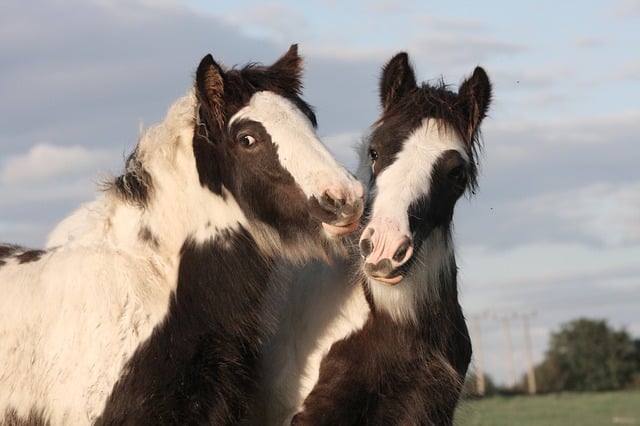Large, thick-haired, and energetic, the Gypsy Vanner horse breed impresses with both appearance and charm. There is a lot more about these horses than look, however. Let’s take a glance at this peculiar and beautiful horse breed.
The Gypsy Vanner Horse Breed
Gypsy Vanners are popular on the Internet for their flashy appearance and funny horse mustache. Of course, it isn’t just on the Internet that these horses are popular.
This horse breed came from the Roma people in the British Isles. Their main purpose was to draw vardos — a type of traveling caravan typical of the Romani. While the Roma people arrived in Britain around the year 1500, they started using the vardos only in 1850.
It would, though, take until after World War II for the breed to truly emerge. It was only in 1996 that a breed registry began — over a hundred years later. This was the Gypsy Vanner Horse Society, followed by several others.
Even today, there aren’t many standards for the breed. The conformation, color, and height can vary quite a bit. Most Gypsy Vanner horses have a black and white (Piebald) coat pattern.
When they first started using vardos, the Romani used mules and cast-off horses, and it was those cast-offs that gave the start to the Gypsy Vanner. Painted Shire horses were out of fashion, allowing the Roma people to acquire them.
It was the Shire Horse and the Clydesdale influence that gave the Gypsy Vanner horse its characteristic feathers on its legs.
Larger horses are hard to maintain, however, and crossbreeding with lighter breeds reduced the size of the Gypsy Vanner considerably. For that, the Roma people used the Dales Pony, which heavily influenced the current horse’s type, and the Fell Pony to a lesser extent.

Best dog photo / Shutterstock.com
Another strong influence came from Section D Welsh Cob, which increased the trot and movement of the horses.
Because of its nature, the Gypsy Vanner was considered a type, rather than a breed, for a long time. Due to its origin, there are no clear indications of ancestry or pedigree for this breed, before the first registries appeared in the 90s. It might be that this horse breed began in Ireland, which is why one of the breed’s name is Irish Cob.
Other names include Gypsy Horse, Gypsy Cob, and Tinker Horse. The “vanner” is the type of horse that draws omnibuses and vans, which was the primary function of the Gypsy Horse. Some people call them just “Cobs”, but the most popular name for this horse breed is still Gypsy Vanner.
Other than its particular coloration, this beautiful horse breed can grow a long mane and thick hair around their hooves. The fairytale look of the breed, as well as its origins, make them look right out of a fairytale.
In this video you can see a Gypsy Vanner stallion driving, under saddle and at liberty, showing the breed’s gracefulness and outstanding looks.

The Gypsy Vanner horse breed is popular for its hair and pinto markings. Breed Stats
Height: Gypsy Vanners range from 13 – 15 hands in height (equal to 52 – 60 inches). Some registries put stricter restraints on the height range, while others divide the horses into Sections A and B according to size.
Colour usually, but not always, piebald. They may have solid colors, sometimes with splashed-white bellies (Blagdon). Breed registries for this horse breed make no color requirement. Spotted horses used to be in fashion, but the pinto ones are more common today.
Conformation the head is “sweet”, that is, refined and in proportion to the body, more delicate than that of a draft horse.
The profile should be flat, and the neck should be strong and muscular. The throat latch should be deeper than in lighter breeds.
The ribs are well sprung, the back is short, the girth is deep, and the hindquarters strong. They are gentle and intelligent. While different associations may have different standards, they all agree that the Gypsy Horse has to have abundant feathering.
Uses today, the Gypsy Vanner may perform all sorts of things, but its primary use is still driving and harness. Due to their striking appearance, Gypsy Vanner breed shows and fairs are quite popular.
Source: horseyhooves.com








